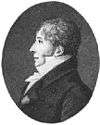La mort d'Adam
La mort d'Adam is an opera ('tragédie lyrique religieuse') in 3 acts by Jean-François Le Sueur with a French libretto by Nicolas-François Guillard after Klopstock, first performed in 1809, though written a few years earlier.[1]
| Operas by Jean-François Le Sueur |
|---|
 |
|
Composition and performance history
Le Sueur wrote the opera while working as an instructor at the Conservatoire de Musique in Paris. The opera was initially scheduled to be performed at the Conservatoire but was dropped in favor of Charles-Simon Catel's Sémiramis. Upset over this decision, Le Sueur published anonymously a pamphlet entitled Projet d'un plan général de l'instruction musicale en France, in which he harshly criticized the methods of instruction followed at the Conservatoire, his rival Catel, and Catel's patron, the director of the Conservatoire. Le Sueur was subsequently fired from the Conservatoire on September 23, 1802 and the composer lived in a state of poverty for about a year before he became maître de chapelle to the First Consul in Paris in early 1804.
Eventually, Le Sueur was able to mount a production of La mort d'Adam. The opera was first performed at the Académie impériale in Paris on March 21, 1809,[2] with a choreography by Louis-Jacques Milon (act 1) and Pierre-Gabriel Gardel (acts 2,3), "but it failed to arouse much enthusiasm and had to be dropped from the repertory permanently on 4 February 1810 after 16 performances".[3]
Winton Dean argues that the opera had a great influence on Berlioz, Le Sueur's pupil shortly after the full score was published, and that "certain elements in Berlioz's style can be explained only by reference to Le Sueur". He points to the distinction between a grand overall design and a restrained, classical means of musical utterance, and to the sequence of separate tableaux of dramatic power with connecting narratives omitted or just implicit; in addition, there are symphonies fantastiques and a symphonie funèbre in La mort d'Adam. Le Sueur annotated his score, in French and Italian, with explanations about the musical language in antiquity which he had incorporated into his work, and some of these devices are found in later works by Berlioz, such as Les Troyens and L'Enfance du Christ.[4]
Roles
| Role | Voice type | Premiere cast[5] 21 Mars 1809 (Conductor:) |
|---|---|---|
| Adam | bass | Henri-Étienne Dérivis |
| Seth | baritone | François Lays or Lay |
| Caïn | tenor | Étienne Lainez |
| L'ombre d'Abel, the shade of Abel | tenor | Louis Nourrit |
| L'ange de la mort, the angel of Death | bass | Mr Bonel |
| Satan | bass | Jean-Honoré Bertin |
| Éve | soprano | Marie-Thérèse Davoux, called Mlle Maillard |
| Sélime | soprano | Mme Granier |
| Sunim | ? | ? |
| Coryphée, coryphaeus | bass | Mr Martin |
| Coryphée, coryphaea | soprano | Mlle Pauline |
References
- Jean Mongrédien. Jean-François Le Sueur. In: The New Grove Dictionary of Opera. Macmillan, London & New York, 1997.
- CATHOLIC ENCYCLOPEDIA: Jean-Francois Lesueur
- Pitou, p. 372.
- Dean, Winton. The New Oxford History of Music (ed Abraham) – The Age of Beethoven 1790-1820, II French Opera. Oxford University Press, London, 1982, p88-90.
- According to the original libretto.
- Original libretto: La mort d'Adam et son apothéose, Tragédie lyrique, En trois actes, Représentée pour la première fois sur le Théâtre de l'Académie Impériale de Musique, le mardi 21 Mars 1809 , Paris, Roullet (printer: Gratiot), 1809 (accessible for free online at Books Google)
- Pitou, Spire, The Paris Opéra. An Encyclopedia of Operas, Ballets, Composers, and Performers – Rococo and Romantic, 1715-1815, Greenwood Press, Westport/London, 1985 (ISBN 0-313-24394-8)
- Amadeus Almanac, accessed 14 August 2008